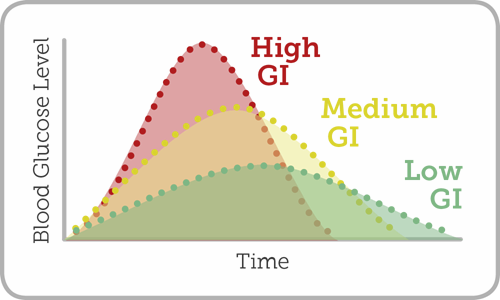Glycaemic Index
How carbs can impact your blood glucose
The rate at which carbohydrate impacts on blood glucose depends mainly on the amount (carbohydrate load) and to a lesser extent, the type of carbohydrate (glycaemic index).
The Glycaemic Index (GI) is a scale from 1 to 100 that is used to measure how quickly foods that contain carbohydrate raise blood glucose levels. Foods that contain carbohydrate are given a GI value; foods that have little or no carbohydrates such as cheese, meat, fish and eggs will have no GI value.

The diagram above demonstrates how low, medium and high GI foods can affect blood glucose over time.
Carbohydrate foods that break down quickly during digestion raise blood glucose more quickly, and have a higher GI value (greater than 70). Foods that break down more slowly during digestion raise blood glucose more slowly and have a lower GI value (less than 55)
The diagram above demonstrates how low, medium and high GI foods can affect blood glucose over time.
Low, Medium and High GI Foods
The table below illustrates the GI value of commonly eaten foods and drinks
|
Low GI Less than 55 |
Medium GI 55 - 70 |
Higher GI Greater than 70 |
|
| Breakfast cereals |
All Bran, Sultana Bran, muesli, porridge oats |
Instant porridge, Weetabix, Shredded Wheat, Special K |
Coco Pops, Rice Krispies, Cornflakes, Cheerios
|
| Bread, biscuits, cakes, confectionery |
Rye bread, pumpernickel bread |
Granary/multi-grain bread, pitta bread, wholemeal bread, crumpet, digestives, rich tea, crisps, chocolate |
French stick, white bread, bagel |
| Potatoes, rice, pasta |
Sweet potatoes, noodles, macaroni, spaghetti |
New potatoes, boiled potatoes, cous cous, brown rice, basmati |
Instant potatoes, baked potatoes, instant rice, french fries, chips |
| Fruit and vegetables |
Apples, grapefruit, grapes, kiwis, oranges, pears, peaches, carrots, green peas |
Apricots, mangoes, pineapples, raisins, sultanas, melons |
Watermelon, turnip, parsnips |
| Beans and pulses |
Baked, butter, black, kidney beans, chick peas, lentils, nuts |
Broad beans |
|
| Milk and dairy |
Milk, custard, yoghurt |
Ice cream |
- Low GI foods are not always healthy for example ice cream, nuts and chocolate all have a low to medium GI but are high in fat and calories. Such items should be eaten in small quantities.
- High GI foods can be a good source of nutrients, for example watermelon, so do not need to be removed just because they have a rapid and large effect on blood glucose levels.
- Focus on the overall GI content of your meal to keep blood glucose levels within target range.
- For a healthy, balanced approach to eating, include low fat and low sugar foods with lower GI options as a basis for meals and snacks
- The key is to use the Glycaemic Index in the context of balanced eating. A healthy way to use the GI principles is to incorporate a range of lower GI carbohydrates that are also low in fat and calories into your meals.
Related information
Resources
The GI diet guide
Information about the low glycemic index (GI) diet & free illustrated low GI recipes
Carb and cals app
This visual app is perfect for those counting carbs, monitoring calories or looking to improve portion control.
BDA food fact sheets
Food fact sheets written by dietitians to help you learn the best ways to eat and drink to keep your body fit and healthy.




















